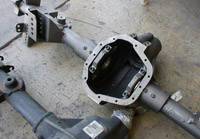Common Axle Terms
AUTOMATIC LOCKER – traction control device that locks and unlocks the differential automatically with no direct input from the driver. BACKLASH – The amount of clearance or play between the ring and pinion gears.BEARING CAP – Component within the axle housing that is bolted in place to secures the differential bearings and differential assembly in place.
BEARING CONE – The inner race of a tapered roller bearing.
BEARING CUP – The outer race of a bearing assembly.
CARRIER – The casting center section of a drive axle that contains the differential assembly, ring gear, pinion gear and support bearings. (NOTE: the term ‘CARRIER’ is often times used to describe what is know as the ‘DIFFERENTIAL’)
CHROMOLY – An abbreviation for “chromium-molybdenum steel” (sometimes spelled “cro-mo”). Chromoly is a range of low alloy steels that is not as lightweight as aluminum alloys but has the advantages of high tensile strength and malleability. It is also easily welded and is considerably stronger and more durable than standard 1020 steel.
DIFFERENTIAL – The gear arrangement inside the center of a drive axle that allows the drive wheels to be driven at different speeds and divides the input torque of one shaft between two output shafts. Also known as the “pumpkin.” (NOTE: the ‘DIFFERENTIAL’ is often times referred to as a ‘CARRIER’)
DIFFERENTIAL COVER – The outside cover that is bolted onto the open face of the carrier. Also known as a ‘DIFF COVER’
END YOKE – Yoke-shaped forging that forms part of the universal joint connection on the front axle shafts.
SHIM – Thin spacer used to adjust preloads and ring gear to pinion gear backlash. May also be used for controlling pinion gear positions.
GEAR – A wheel with teeth that transmits power or motion to another gear.
GEAR RATIO – The ratio in the number of teeth on the ring gear and the pinion gear.
HOUSING – Portion of the axle assembly that consists of the carrier and axle tubes.
LIMITED SLIP DIFFERENTIAL – Differential in which the difference in rotational speed or torque between two output shafts is mechanically limited to prevent wheel spin on difficult terrain.
LOCKER – A variation of the differential, a locking differential restricts each of the two wheels on an axle and forces them to rotate at the same speed without regard to available traction or differences in resistance seen at each wheel.
PINION GEAR – A small gear that meshes with a larger gear.
PRELOAD – A load placed on parts during assembly to maintain critical clearances and adjustments when operating loads are applied.
RING GEAR – The large gear that is attached to the carrier and meshes with the pinion gear.
SELECTABLE LOCKER – Traction control device that allows the driver to lock and unlock the differential at will from the driver’s seat.
SPLINE – Thin narrow groves created on the end of a shaft that allows it to mate perfectly with matching groves on another component.
|





















This is by far the best write up to date!!!!!
Thanks for the write-up, this is exactly the type of thing I had in mind when I pm’d you a while back with that spline question.
absolutely awesome Eddie, this should be a mandatory document to be read by all newbies
great job on this
Hi to all JK drivers and Jeep fans.
First of all I like to bag for your pardon for my poor english and send you best regards from Germany, especially from the Jeep Club Germany.
In about 6 month I´am going to replace my WH Grand Cherokee 3.0 CRD with a Jeep JK Wrangler Unlimited Rubicon 2.8 Diesel with manual 6 gear transmission. But compared to the rock crawling pimps which are discussed here mostly, I like to build up a long range and desert travel Wrangler. This means Long Ranger Fuel Tank, OME heavy duty springs, koni heavy track shocks, black widow storage system with 70liters water tank, Safari Snorkel with zyklone, 35″ tiers, K&N air intake filter, additional fuel cleaner, Warn winch and ARB bumper, dual friction clutch, park heating, two optima batteries, special batterie charging system, roof rack, Tom Woods drive shafts and so on and so on.
But this not the story – I need your assistance, experience and support concerning the axles. The Dana 44 new generation axles will be fine in the front I hope. But for the rear axle I`am thinking about upgrading to the dana 60 or maybe just changing the 44 to a superior chromoly axle shaft.
I hope you could help, even if I like to use my jeep differently to the rock crawling – in the end it must be a durable long travel offroader, which can be used with the needed additional load for a two week trip, thousands kilometers and tough speed trough the african desert dunes and humpy dirt tracks.
Thanks a lot in advance for your serious support – Steven.
Thanks for that!!! ive been looking and looking for this wright up! now i understand!
I have an 08 JK X model that I would like to put 35″ tires on. I have been told that the dana 30 that is on the front will not be strong enough and that I will break axles. What is a good guide to know what size tires can go with they type of axles? Last thing I want to do it get on the trail and break due to poor design.
i would like to know if the 2014 jeep sahara front axle will be fit in a 2013 jeep wrangler sport both 2 doors